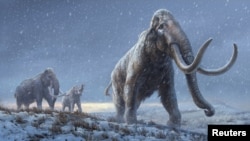Scientists say they have discovered the oldest DNA on record. It was found in the teeth of mammoths that lived in northeastern Siberia up to 1.2 million years ago.
A mammoth was a kind of early elephant that lived during the Ice Age. The discovery may lead to a greater understanding of the long-dead species.
DNA is the substance that carries genetic information in the cells of living things. The researchers say they recovered and sequenced DNA from the remains of three mammoths.
The remains -- which were contained in permanently frozen ground -- were discovered beginning in the 1970s. But scientists at the time did not have the ability to find and remove the DNA.
The oldest of the three mammoths was discovered near the Krestovka River in Siberia. It was about 1.2 million years old. Another, from near the Adycha River, was between 1 to 1.2 million years old. The third, from near the Chukochya River, was around 700,000 years old.
The discovery was by far “the oldest DNA ever recovered,” said geneticist Love Dalén of the Center for Palaeogenetics in Sweden. He led the research, which was recently described in a study in the publication Nature.
Until now, the oldest DNA on record was from the leg bone of a horse that lived in Canada’s Yukon territory. Scientists estimated the horse was between 560,000 to 780,000 years old.
By comparison, our own species, Homo sapiens, is believed to have first appeared about 300,000 years ago.
The mammoth DNA “was extremely degraded into very small pieces,” Dalén said. He explained that scientists had to sequence billions of pieces of genetic material in order to find a final DNA sequence.
Most knowledge about prehistoric creatures comes from studying skeletal fossils. But ancient DNA can provide much more detailed information about individual organisms.
However, DNA can be damaged over time. New research methods are now permitting scientists to recover even older DNA.
As these methods further develop, Dalén said he thinks it should be possible to work with DNA that is up to three million years old.
Such methods could lead to a greater knowledge about a number of older species. They can provide valuable information about the way new species formed, which fossils cannot, Dalén said.
However, the methods will not be enough to help us better understand the dinosaurs, which died out about 65 million years ago.
The researchers learned about the development and migration of mammoths by comparing the DNA to that of mammoths that lived more recently. The last mammoths died out about 4,000 years ago.
DNA from the Krestovka mammoth shows that it split off from the well-known woolly mammoth about 2 million years ago.
Geneticist Tom van der Valk helped lead the research. He said it appears that members of the Krestovka mammoth family were the first mammoths to move from Siberia into North America about 1.5 million years ago.
I’m Susan Shand.
The Reuters News Agency reported on this story. Susan Shand adapted it for Learning English. Bryan Lynn was the editor.
________________________________________________________________
Words in This Story
species – n. a group of animals or plants that are similar
sequence – v. determine the order of chemical building blocks
degrade – v. damage the quality or condition of something
fossil – n. part of an animal or plant from thousands of year ago, preserved in rock
We want to hear from you. Write to us in the Comments Section.










